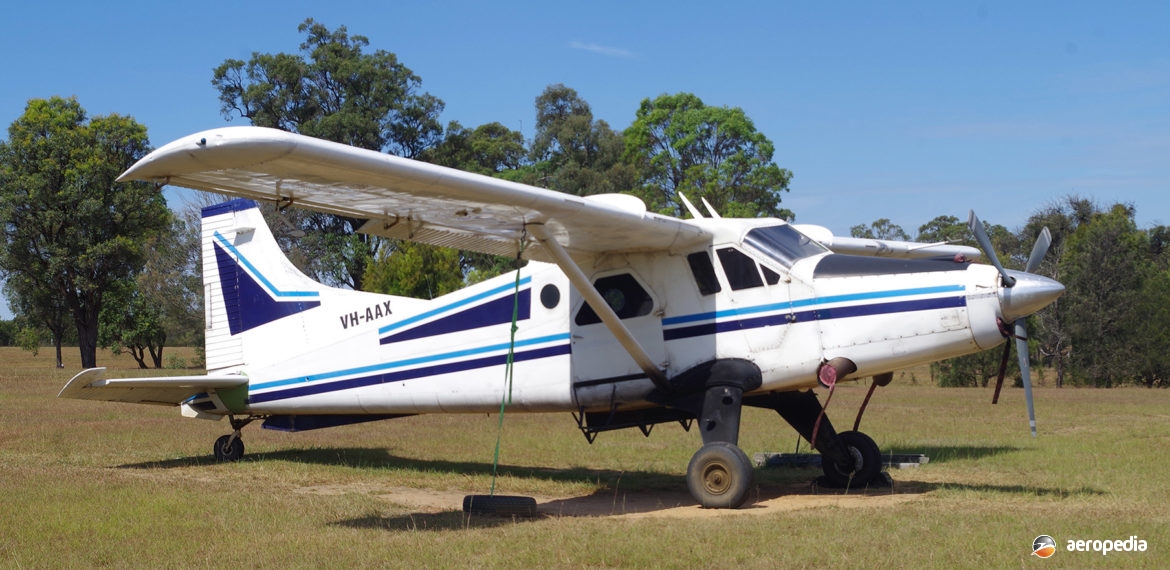Photograph:
de Havilland DHC-2 Turbo Beaver ‘Wallaroo 605’ VH-AAX (c/n 1411) at Wilton, NSW in October 2011 (David C Eyre)
Country of origin:
Canada
Description:
Light utility transport
Power Plant:
One 431 kw (578 shp) Pratt & Whitney Canada PT6A-6 or PT6A-20 turboprop
Specifications:
- Wingspan: 14.6 m (48 ft)
- Length: 10.71 m (35 ft 2 in)
- Height: 3.12 m (10 ft 3 in)
- Wing area: 23.22 m² (250 sq ft)
- Max speed: 273 km/h (170 mph)
- Max cruising speed: 253 km/h (157 mph)
- Economical cruising speed at 1,524 m (5,000 ft): 225 km/h (140 mph)
- Initial rate of climb: 361 m/min (1,185 ft/min)
- Service ceiling: 6,370 m (20,900 ft)
- Max range with 454 kg (1,000 lb) payload at 1,524 m (5,000 ft): 981 km (610 miles)
- Empty weight: 1,175 kg (2,590 lb)
- Loaded weight: 2,313 kg (5,100 lb)
History:
The de Havilland DHC-2 Mk III Turbo Beaver was a logical step from the piston-engined Beaver to provide a more modern power plant and greater capacity. A development of the Mk I, the prototype Turbo Beaver was flown for the first time on 30 December 1963 and deliveries of production aircraft commenced late in 1964. Able to be fitted with wheels, floats or ski undercarriages, the new model differed from the Mk I in having a lengthened fuselage, re-design of the tail surfaces, and the usual changes required with the installation of a turboprop engine. Accommodation was provided for nine to eleven persons. Only a small number of Turbo Beavers were built, although a number were converted by their owners in Canada.
Some conversions of Beavers were made by Volpar, this variant being known as the Model 4000. This model was first developed in April 1972 and was fitted with an AiResearch TPE331-2U-203 turboprop driving a three-blade propeller. Other changes included a re-designed fin and rudder. Viking Aircraft, which in later years placed the DHC-6 Twin Otter back in production, also made upgrades to Beavers, fitting a 507 kw (680 hp) Pratt & Whitney Canada PT6A-34 turboprop.
One Mk III Turbo Beaver was imported to Australia in April 1967 and became VH-UKL (c/n 1627-B16). Assembled at Bankstown, NSW, it was operated in the Antarctic during the 1968-1969 Australian National Antarctic Research Expedition (ANARE) on skis alongside two Hiller 1100 turbine-powered helicopters of Helicopter Utilities (VH-UTZ and VH-UHD). The aircraft were shipped to and from the Antarctic on board the Antarctic vessel ‘Nella Dan’. On completion of duties, the Beaver was shipped back to Canada as CF-UKL.
One Australian Mk I Beaver, VH-AAX (c/n 1411), was converted in 1967 by Aerial Agriculture at Bankstown, NSW, to Mk III Turbo Beaver configuration by the installation of a Pratt & Whitney Canada PT6 turboprop. It had a unique fuselage extension and a modified fin and rudder, also of Australian design, and became known as the ‘Wallaroo 605’. In the event, it only operated in this configuration for a year or so and then was converted back to the radial engine installation.
During 1986 the wheel turned a complete circle, as VH-AAX was again fitted with turboprop power, this time a Garrett AiResearch TPE331-61, and became registered in September that year to Aviation Industries, later with Mobile Carpet Cleaning of Bankstown, NSW. Over the years it has operated from Wilton, NSW and other centres in the parachuting role, even as far afield as north Queensland. By 2020 it was beng operated by Skydive Oz Pty Ltd of Moruya, NSW and later Jump Aviation Pty Ltd, Trustee for the Jump Aviation Trust.
In about 1986 it was rebuilt for its the owner Erinnfly Pty Ltd of Caringbah, NSW and was based at Bankstown, NSW. During this restoration it was fitted with a Garrett Turbine Engine Company TPE331-1-201A engine thought to have been removed from a retired Short Skyvan.
On 26 October 1990 it suffered an engine failure in the Hunter Valley, NSW and was extensively damaged in the subsequent forced landing. It was again restored.

